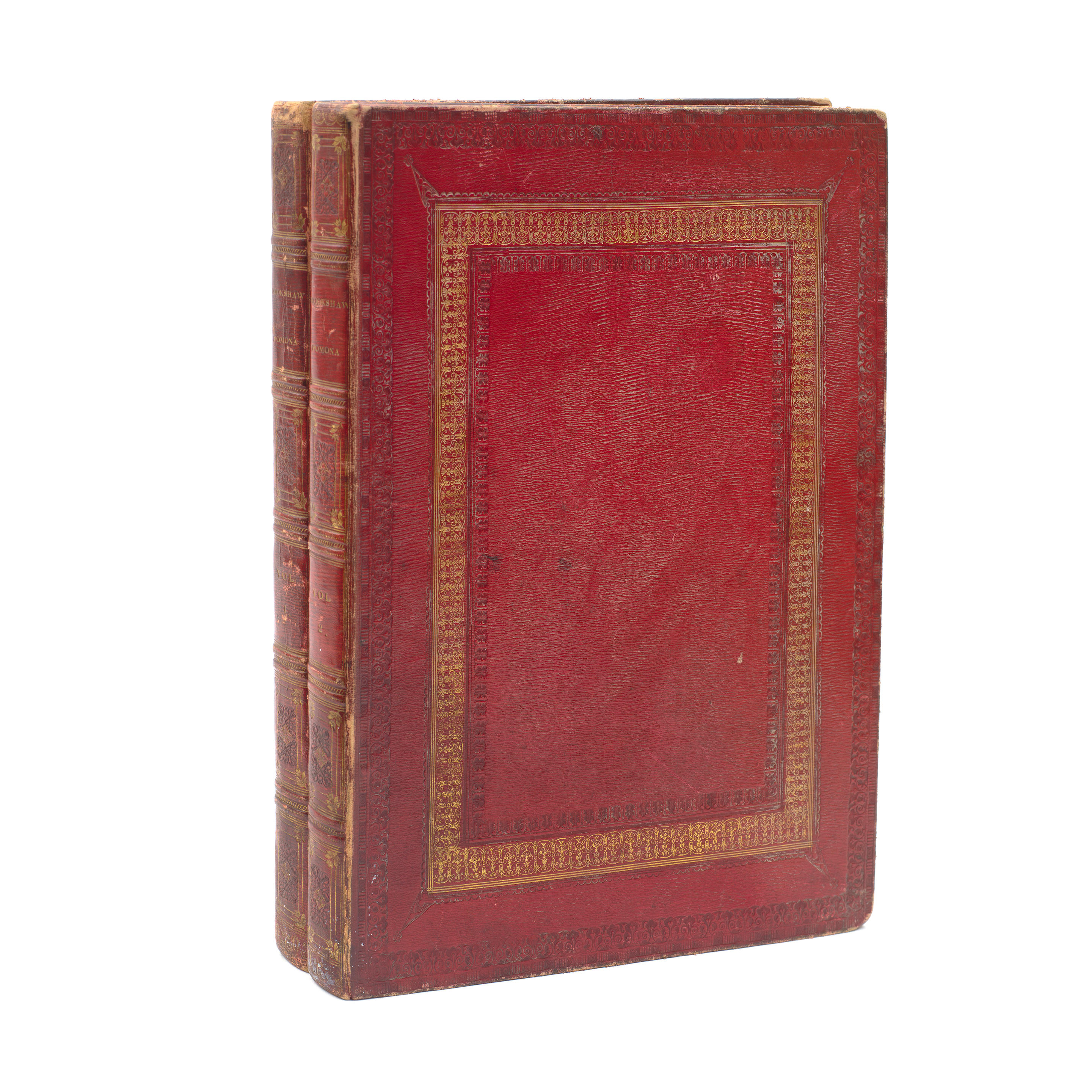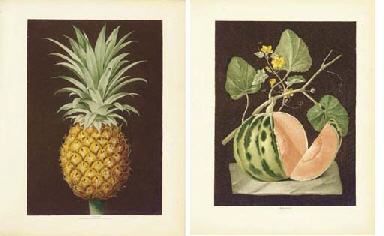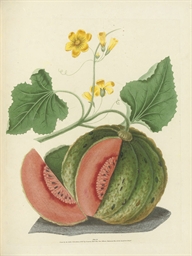BROOKSHAW, George (1751-1823). Pomona Britannica; or, a collection of the most esteemed fruits at present cultivated in this country. London: T. Bensley for the author, published by White, Cochrane and Co., E. Lloyd and W. Lindsell, [1804-]1812. Large broadsheets (574 x 459mm). 90 AQUATINT AND STIPPLE-ENGRAVED PLATES BY G. BROOKSHAW, PRINTED IN COLOUR AND FINISHED BY HAND, with the author's printed slip explaining the absence of three pineapple plates, 1 page index. (Front free endpaper and first three leaves creased, occasional extremely faint offsetting, plate III with two paper fault tears at edge of plate-mark.) Contemporary maroon straight-grained morocco, covers panelled in gilt and blind employing rules and elaborate stylised foliage rolls, the smaller inner gilt roll also including bee-hive, helmet, lyre, shell, thistle, rose and shamrock, the spine in seven sections with raised bands, lettered in two, the others with overall arabesque decoration composed of various small tools, g.e. (spine slightly faded and lightly rubbed at head and foot, occasional minor scuff-marks to covers). A FINE COPY OF THE FIRST EDITION OF THE FINEST ENGLISH WORK ON FRUIT. 256 varieties of fruit are depicted in the 90 plates, which were engraved by Richard Brookshaw and H. Merke (plate 48). Richard Brookshaw probably the author's elder brother, was a mezzotint engraver who found popularity in France: his plates in the Pomona , dated 1804, are his last recorded works. The Pomona marked the re-emergence of George Brookshaw into the public eye after a total disappearance of nearly a decade. Until recently, little has been known of Brookshaw's life, but in a recent article ("George Brookshaw: The case of the vanishing cabinet-maker", Apollo , May 1991) Lucy Wood has uncovered many details in the remarkable story of a man who began his career as a celebrated cabinet-maker and died a relatively unappreciated botanical artist - and seems to have deliberately obscured many of the connections between his two personae. Brookshaw, born in Birmingham and married to the daughter of a prosperous Birmingham gunsmith, moved to London in 1777 to embark on a career as a cabinet-maker. By 1783 he had attracted the patronage of the Prince of Wales and other prominent members of society: his furniture was noted for its all-over painted decoration with figurative, landcsape and, above all, floral themes. An inscription on one of his bills presented to the Prince of Wales in 1783 describes him as a 'Peintre Ebéniste par Extraordinaire'. However, no record survives of any furniture made by him after the mid-1790s: at this point, Lucy Wood suggests that a financial or sexual scandal drove him to live and work under a false name and precipitated his embarkation on an entirely new career. She believes that A New Treatise on Flower Painting , published anonymously in 1797 and later (in the third edition of 1799) in the name of G. Brown, was actually by Brookshaw, whose A Supplement to the Treatise on Flower Painting published in 1817 has largely the same content - including 11 plates supposedly by Brookshaw but identical to those in the earlier work, where they are attributed to Brown. Blanche Henrey (II, pp. 595-8) although not reaching the same conclusion, also draws attention to the similarity of the two works and the fact that Brookshaw makes no acknowledgement of Brown's work, as well as to the conspicuous lack of biographical details for either man. The Pomona was first issued in parts from 1804 to 1808 (apart from two plates dated 1812) and, if Wood's hypothesis is correct, is the first resumption by Brookshaw of his own name, as well as the first public indication of his new métier. The first edition of the complete work was published in 1812 and was dedicated to the Prince Regent, Brookshaw's most distinguished former patron. Many of the specimens were taken from the Royal Gardens at Hampton Court and Kensington Gardens. Other gardens mentioned in the te
BROOKSHAW, George (1751-1823). Pomona Britannica; or, a collection of the most esteemed fruits at present cultivated in this country. London: T. Bensley for the author, published by White, Cochrane and Co., E. Lloyd and W. Lindsell, [1804-]1812. Large broadsheets (574 x 459mm). 90 AQUATINT AND STIPPLE-ENGRAVED PLATES BY G. BROOKSHAW, PRINTED IN COLOUR AND FINISHED BY HAND, with the author's printed slip explaining the absence of three pineapple plates, 1 page index. (Front free endpaper and first three leaves creased, occasional extremely faint offsetting, plate III with two paper fault tears at edge of plate-mark.) Contemporary maroon straight-grained morocco, covers panelled in gilt and blind employing rules and elaborate stylised foliage rolls, the smaller inner gilt roll also including bee-hive, helmet, lyre, shell, thistle, rose and shamrock, the spine in seven sections with raised bands, lettered in two, the others with overall arabesque decoration composed of various small tools, g.e. (spine slightly faded and lightly rubbed at head and foot, occasional minor scuff-marks to covers). A FINE COPY OF THE FIRST EDITION OF THE FINEST ENGLISH WORK ON FRUIT. 256 varieties of fruit are depicted in the 90 plates, which were engraved by Richard Brookshaw and H. Merke (plate 48). Richard Brookshaw probably the author's elder brother, was a mezzotint engraver who found popularity in France: his plates in the Pomona , dated 1804, are his last recorded works. The Pomona marked the re-emergence of George Brookshaw into the public eye after a total disappearance of nearly a decade. Until recently, little has been known of Brookshaw's life, but in a recent article ("George Brookshaw: The case of the vanishing cabinet-maker", Apollo , May 1991) Lucy Wood has uncovered many details in the remarkable story of a man who began his career as a celebrated cabinet-maker and died a relatively unappreciated botanical artist - and seems to have deliberately obscured many of the connections between his two personae. Brookshaw, born in Birmingham and married to the daughter of a prosperous Birmingham gunsmith, moved to London in 1777 to embark on a career as a cabinet-maker. By 1783 he had attracted the patronage of the Prince of Wales and other prominent members of society: his furniture was noted for its all-over painted decoration with figurative, landcsape and, above all, floral themes. An inscription on one of his bills presented to the Prince of Wales in 1783 describes him as a 'Peintre Ebéniste par Extraordinaire'. However, no record survives of any furniture made by him after the mid-1790s: at this point, Lucy Wood suggests that a financial or sexual scandal drove him to live and work under a false name and precipitated his embarkation on an entirely new career. She believes that A New Treatise on Flower Painting , published anonymously in 1797 and later (in the third edition of 1799) in the name of G. Brown, was actually by Brookshaw, whose A Supplement to the Treatise on Flower Painting published in 1817 has largely the same content - including 11 plates supposedly by Brookshaw but identical to those in the earlier work, where they are attributed to Brown. Blanche Henrey (II, pp. 595-8) although not reaching the same conclusion, also draws attention to the similarity of the two works and the fact that Brookshaw makes no acknowledgement of Brown's work, as well as to the conspicuous lack of biographical details for either man. The Pomona was first issued in parts from 1804 to 1808 (apart from two plates dated 1812) and, if Wood's hypothesis is correct, is the first resumption by Brookshaw of his own name, as well as the first public indication of his new métier. The first edition of the complete work was published in 1812 and was dedicated to the Prince Regent, Brookshaw's most distinguished former patron. Many of the specimens were taken from the Royal Gardens at Hampton Court and Kensington Gardens. Other gardens mentioned in the te



.jpg)









.jpg)
Try LotSearch and its premium features for 7 days - without any costs!
Be notified automatically about new items in upcoming auctions.
Create an alert